Clinical Reasoning Cycle
VerifiedAdded on 2023/01/11
|8
|1939
|58
AI Summary
This article discusses the use of the clinical reasoning cycle to analyze and provide interventions for a case of clinical depression in a 38-year-old woman. It explores the patient's situation, collection of cues and information, processing of the information, identification of the problem, establishment of goals, taking action, evaluation of the goals, and reflection. The article also includes references to relevant research studies.
Contribute Materials
Your contribution can guide someone’s learning journey. Share your
documents today.
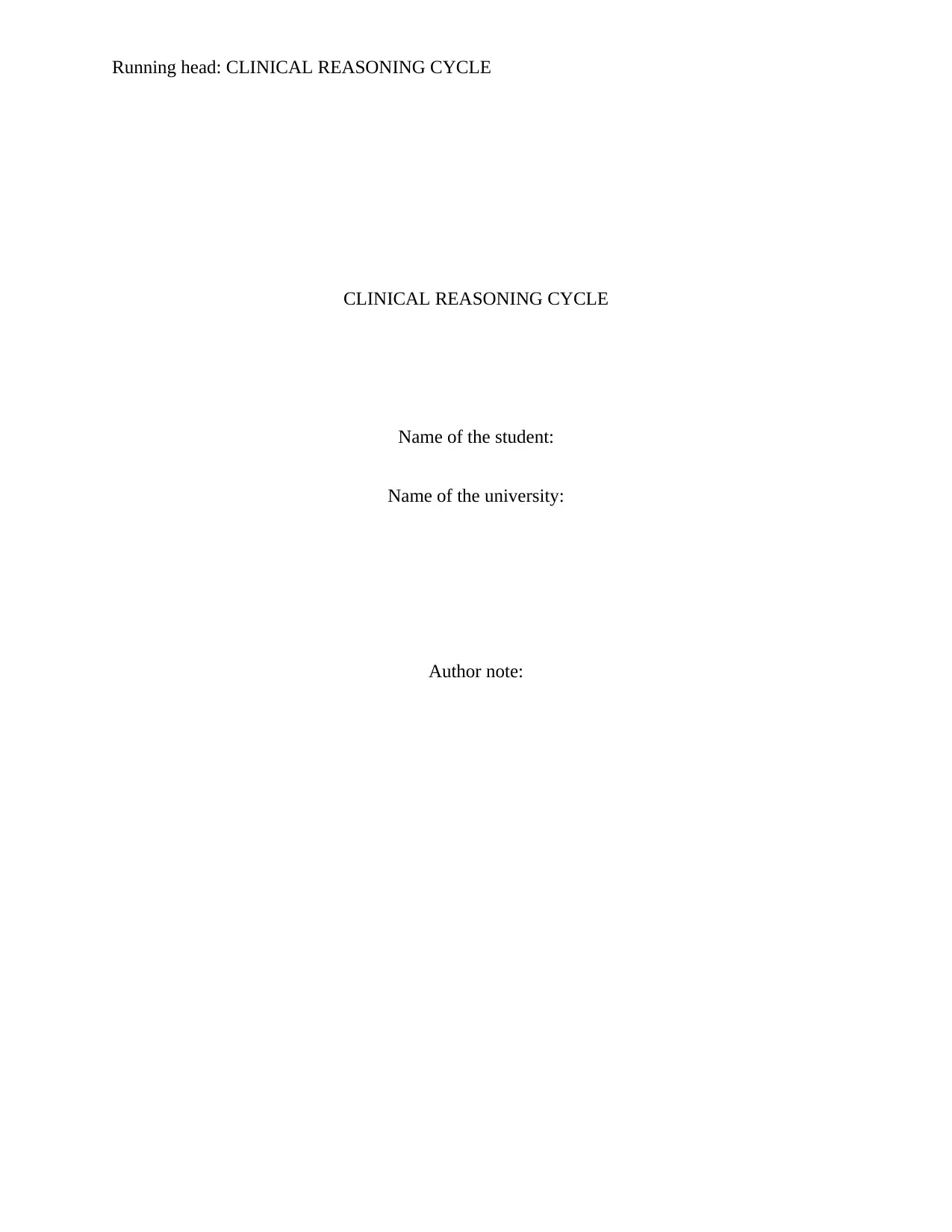
Running head: CLINICAL REASONING CYCLE
CLINICAL REASONING CYCLE
Name of the student:
Name of the university:
Author note:
CLINICAL REASONING CYCLE
Name of the student:
Name of the university:
Author note:
Secure Best Marks with AI Grader
Need help grading? Try our AI Grader for instant feedback on your assignments.
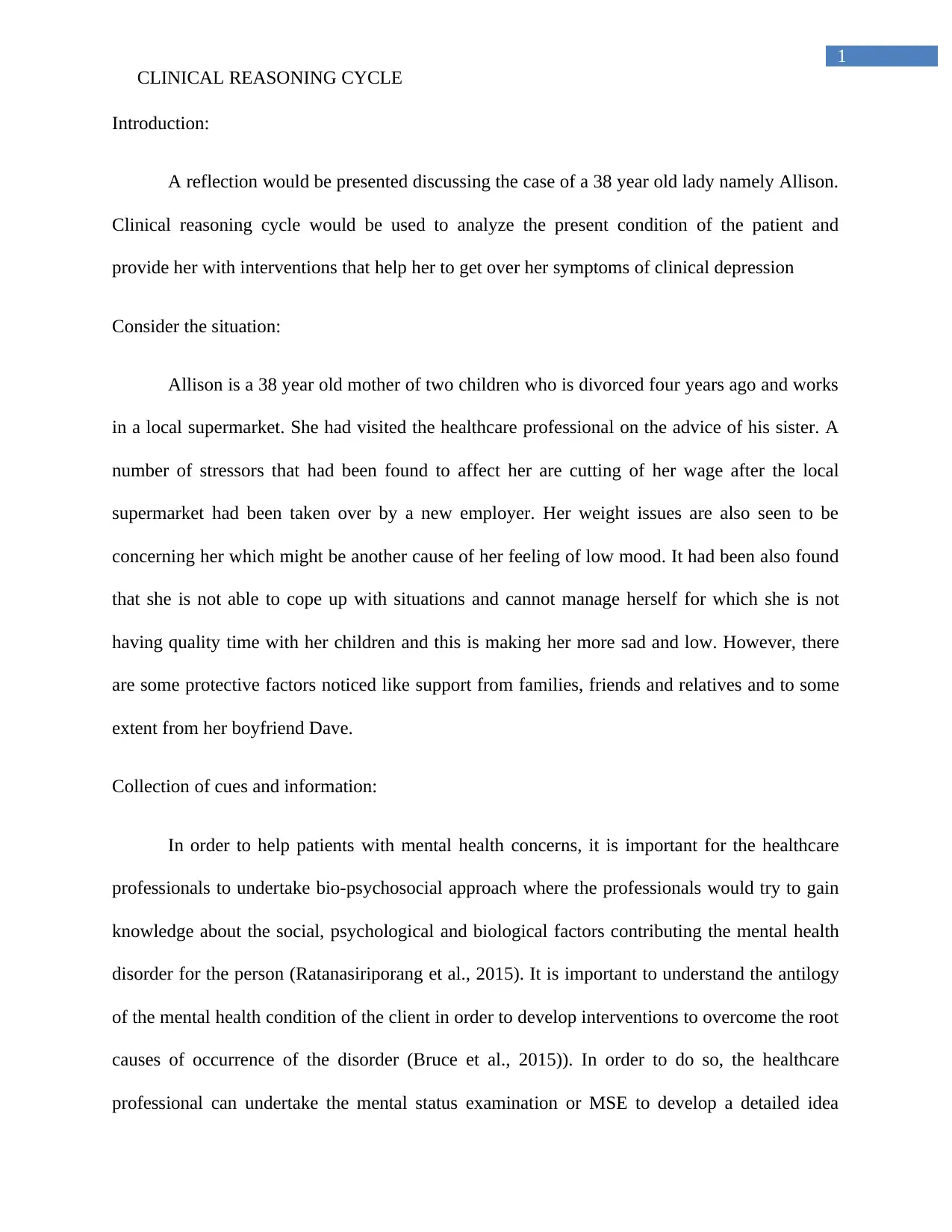
1
CLINICAL REASONING CYCLE
Introduction:
A reflection would be presented discussing the case of a 38 year old lady namely Allison.
Clinical reasoning cycle would be used to analyze the present condition of the patient and
provide her with interventions that help her to get over her symptoms of clinical depression
Consider the situation:
Allison is a 38 year old mother of two children who is divorced four years ago and works
in a local supermarket. She had visited the healthcare professional on the advice of his sister. A
number of stressors that had been found to affect her are cutting of her wage after the local
supermarket had been taken over by a new employer. Her weight issues are also seen to be
concerning her which might be another cause of her feeling of low mood. It had been also found
that she is not able to cope up with situations and cannot manage herself for which she is not
having quality time with her children and this is making her more sad and low. However, there
are some protective factors noticed like support from families, friends and relatives and to some
extent from her boyfriend Dave.
Collection of cues and information:
In order to help patients with mental health concerns, it is important for the healthcare
professionals to undertake bio-psychosocial approach where the professionals would try to gain
knowledge about the social, psychological and biological factors contributing the mental health
disorder for the person (Ratanasiriporang et al., 2015). It is important to understand the antilogy
of the mental health condition of the client in order to develop interventions to overcome the root
causes of occurrence of the disorder (Bruce et al., 2015)). In order to do so, the healthcare
professional can undertake the mental status examination or MSE to develop a detailed idea
CLINICAL REASONING CYCLE
Introduction:
A reflection would be presented discussing the case of a 38 year old lady namely Allison.
Clinical reasoning cycle would be used to analyze the present condition of the patient and
provide her with interventions that help her to get over her symptoms of clinical depression
Consider the situation:
Allison is a 38 year old mother of two children who is divorced four years ago and works
in a local supermarket. She had visited the healthcare professional on the advice of his sister. A
number of stressors that had been found to affect her are cutting of her wage after the local
supermarket had been taken over by a new employer. Her weight issues are also seen to be
concerning her which might be another cause of her feeling of low mood. It had been also found
that she is not able to cope up with situations and cannot manage herself for which she is not
having quality time with her children and this is making her more sad and low. However, there
are some protective factors noticed like support from families, friends and relatives and to some
extent from her boyfriend Dave.
Collection of cues and information:
In order to help patients with mental health concerns, it is important for the healthcare
professionals to undertake bio-psychosocial approach where the professionals would try to gain
knowledge about the social, psychological and biological factors contributing the mental health
disorder for the person (Ratanasiriporang et al., 2015). It is important to understand the antilogy
of the mental health condition of the client in order to develop interventions to overcome the root
causes of occurrence of the disorder (Bruce et al., 2015)). In order to do so, the healthcare
professional can undertake the mental status examination or MSE to develop a detailed idea
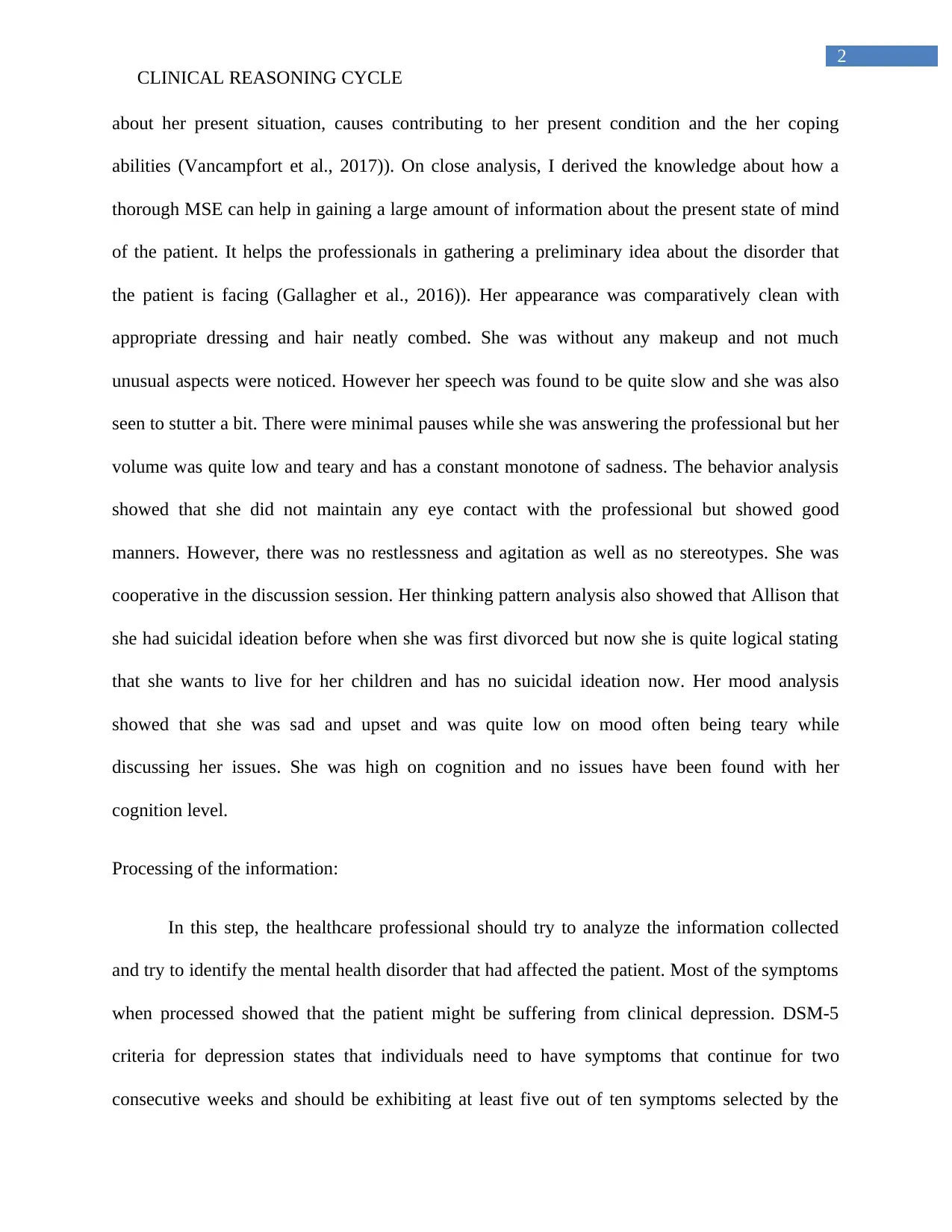
2
CLINICAL REASONING CYCLE
about her present situation, causes contributing to her present condition and the her coping
abilities (Vancampfort et al., 2017)). On close analysis, I derived the knowledge about how a
thorough MSE can help in gaining a large amount of information about the present state of mind
of the patient. It helps the professionals in gathering a preliminary idea about the disorder that
the patient is facing (Gallagher et al., 2016)). Her appearance was comparatively clean with
appropriate dressing and hair neatly combed. She was without any makeup and not much
unusual aspects were noticed. However her speech was found to be quite slow and she was also
seen to stutter a bit. There were minimal pauses while she was answering the professional but her
volume was quite low and teary and has a constant monotone of sadness. The behavior analysis
showed that she did not maintain any eye contact with the professional but showed good
manners. However, there was no restlessness and agitation as well as no stereotypes. She was
cooperative in the discussion session. Her thinking pattern analysis also showed that Allison that
she had suicidal ideation before when she was first divorced but now she is quite logical stating
that she wants to live for her children and has no suicidal ideation now. Her mood analysis
showed that she was sad and upset and was quite low on mood often being teary while
discussing her issues. She was high on cognition and no issues have been found with her
cognition level.
Processing of the information:
In this step, the healthcare professional should try to analyze the information collected
and try to identify the mental health disorder that had affected the patient. Most of the symptoms
when processed showed that the patient might be suffering from clinical depression. DSM-5
criteria for depression states that individuals need to have symptoms that continue for two
consecutive weeks and should be exhibiting at least five out of ten symptoms selected by the
CLINICAL REASONING CYCLE
about her present situation, causes contributing to her present condition and the her coping
abilities (Vancampfort et al., 2017)). On close analysis, I derived the knowledge about how a
thorough MSE can help in gaining a large amount of information about the present state of mind
of the patient. It helps the professionals in gathering a preliminary idea about the disorder that
the patient is facing (Gallagher et al., 2016)). Her appearance was comparatively clean with
appropriate dressing and hair neatly combed. She was without any makeup and not much
unusual aspects were noticed. However her speech was found to be quite slow and she was also
seen to stutter a bit. There were minimal pauses while she was answering the professional but her
volume was quite low and teary and has a constant monotone of sadness. The behavior analysis
showed that she did not maintain any eye contact with the professional but showed good
manners. However, there was no restlessness and agitation as well as no stereotypes. She was
cooperative in the discussion session. Her thinking pattern analysis also showed that Allison that
she had suicidal ideation before when she was first divorced but now she is quite logical stating
that she wants to live for her children and has no suicidal ideation now. Her mood analysis
showed that she was sad and upset and was quite low on mood often being teary while
discussing her issues. She was high on cognition and no issues have been found with her
cognition level.
Processing of the information:
In this step, the healthcare professional should try to analyze the information collected
and try to identify the mental health disorder that had affected the patient. Most of the symptoms
when processed showed that the patient might be suffering from clinical depression. DSM-5
criteria for depression states that individuals need to have symptoms that continue for two
consecutive weeks and should be exhibiting at least five out of ten symptoms selected by the
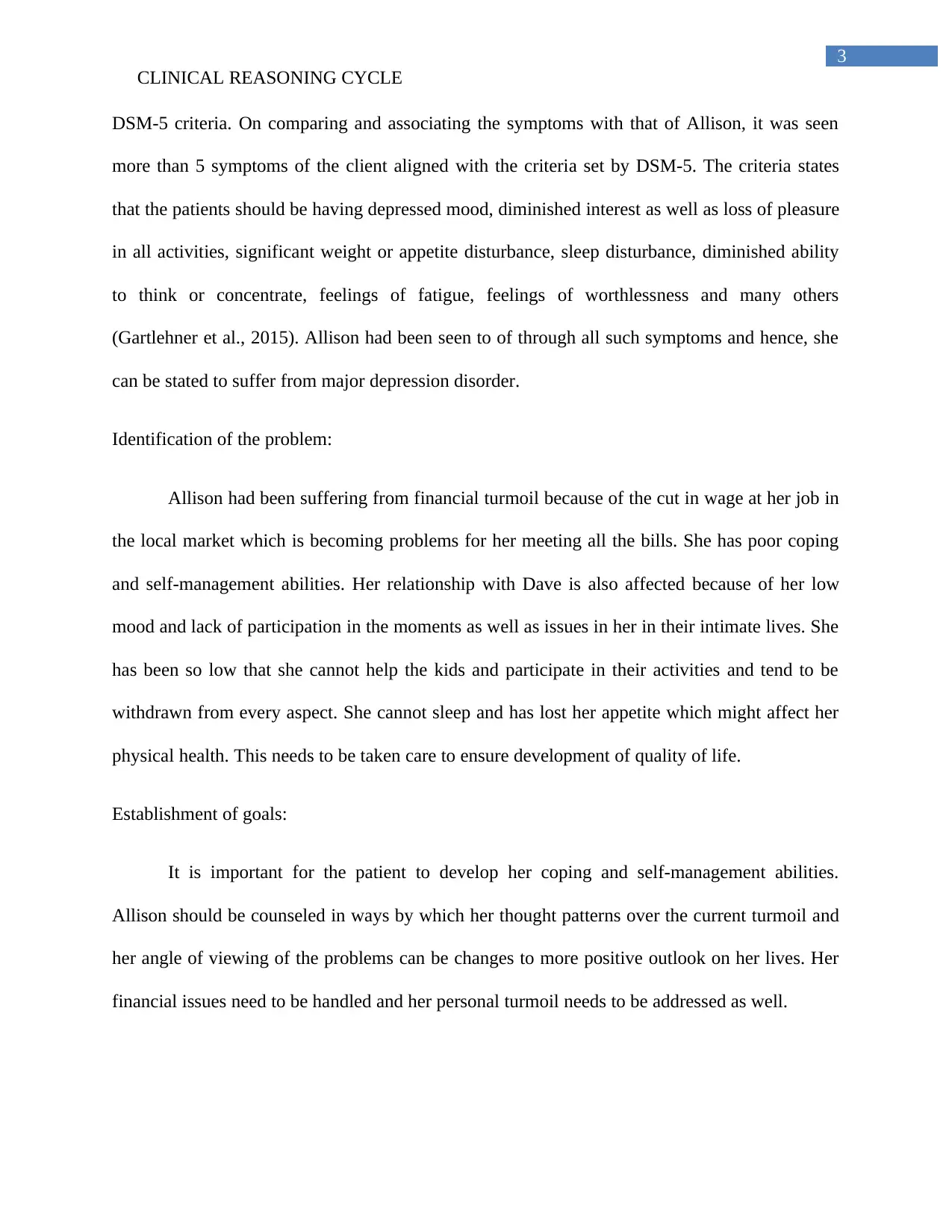
3
CLINICAL REASONING CYCLE
DSM-5 criteria. On comparing and associating the symptoms with that of Allison, it was seen
more than 5 symptoms of the client aligned with the criteria set by DSM-5. The criteria states
that the patients should be having depressed mood, diminished interest as well as loss of pleasure
in all activities, significant weight or appetite disturbance, sleep disturbance, diminished ability
to think or concentrate, feelings of fatigue, feelings of worthlessness and many others
(Gartlehner et al., 2015). Allison had been seen to of through all such symptoms and hence, she
can be stated to suffer from major depression disorder.
Identification of the problem:
Allison had been suffering from financial turmoil because of the cut in wage at her job in
the local market which is becoming problems for her meeting all the bills. She has poor coping
and self-management abilities. Her relationship with Dave is also affected because of her low
mood and lack of participation in the moments as well as issues in her in their intimate lives. She
has been so low that she cannot help the kids and participate in their activities and tend to be
withdrawn from every aspect. She cannot sleep and has lost her appetite which might affect her
physical health. This needs to be taken care to ensure development of quality of life.
Establishment of goals:
It is important for the patient to develop her coping and self-management abilities.
Allison should be counseled in ways by which her thought patterns over the current turmoil and
her angle of viewing of the problems can be changes to more positive outlook on her lives. Her
financial issues need to be handled and her personal turmoil needs to be addressed as well.
CLINICAL REASONING CYCLE
DSM-5 criteria. On comparing and associating the symptoms with that of Allison, it was seen
more than 5 symptoms of the client aligned with the criteria set by DSM-5. The criteria states
that the patients should be having depressed mood, diminished interest as well as loss of pleasure
in all activities, significant weight or appetite disturbance, sleep disturbance, diminished ability
to think or concentrate, feelings of fatigue, feelings of worthlessness and many others
(Gartlehner et al., 2015). Allison had been seen to of through all such symptoms and hence, she
can be stated to suffer from major depression disorder.
Identification of the problem:
Allison had been suffering from financial turmoil because of the cut in wage at her job in
the local market which is becoming problems for her meeting all the bills. She has poor coping
and self-management abilities. Her relationship with Dave is also affected because of her low
mood and lack of participation in the moments as well as issues in her in their intimate lives. She
has been so low that she cannot help the kids and participate in their activities and tend to be
withdrawn from every aspect. She cannot sleep and has lost her appetite which might affect her
physical health. This needs to be taken care to ensure development of quality of life.
Establishment of goals:
It is important for the patient to develop her coping and self-management abilities.
Allison should be counseled in ways by which her thought patterns over the current turmoil and
her angle of viewing of the problems can be changes to more positive outlook on her lives. Her
financial issues need to be handled and her personal turmoil needs to be addressed as well.
Secure Best Marks with AI Grader
Need help grading? Try our AI Grader for instant feedback on your assignments.
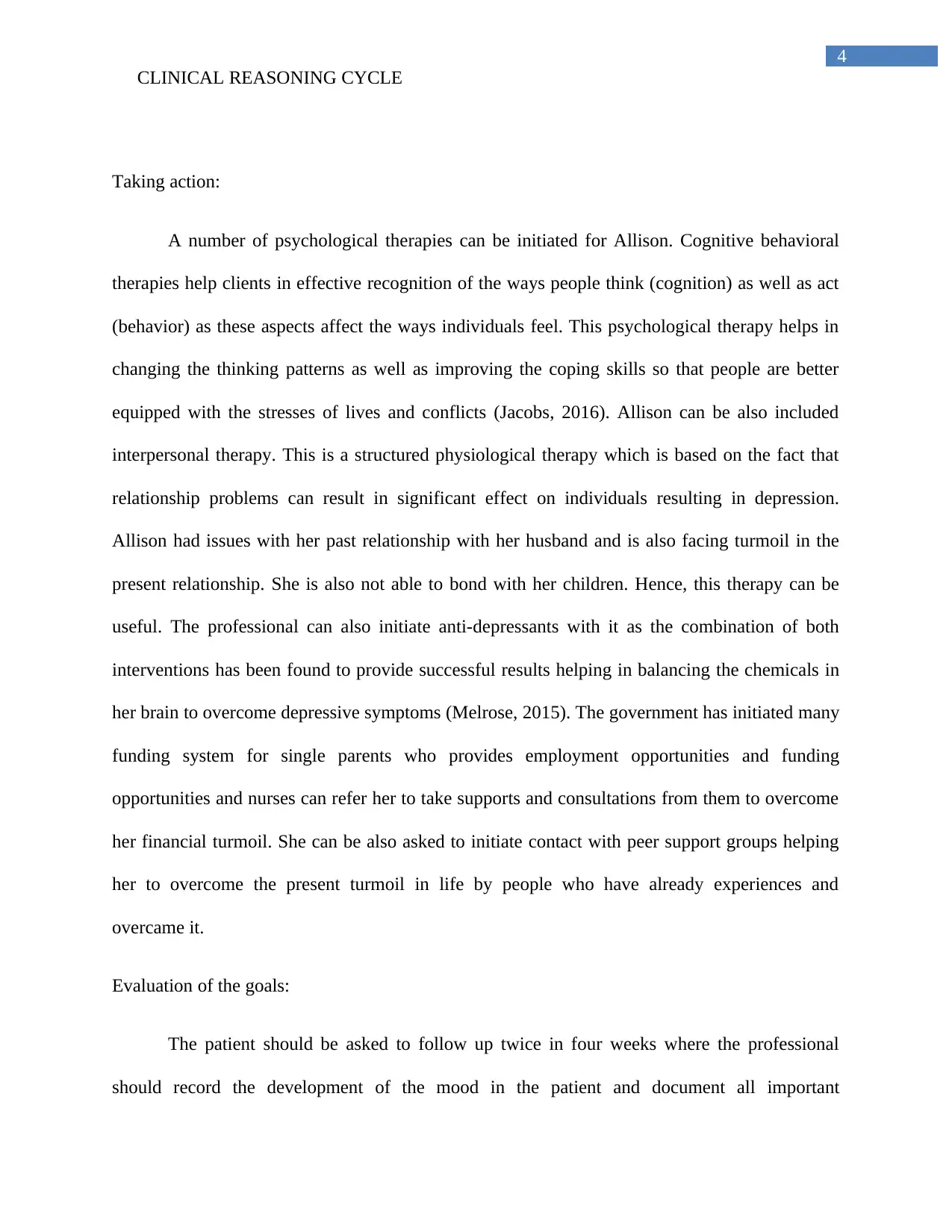
4
CLINICAL REASONING CYCLE
Taking action:
A number of psychological therapies can be initiated for Allison. Cognitive behavioral
therapies help clients in effective recognition of the ways people think (cognition) as well as act
(behavior) as these aspects affect the ways individuals feel. This psychological therapy helps in
changing the thinking patterns as well as improving the coping skills so that people are better
equipped with the stresses of lives and conflicts (Jacobs, 2016). Allison can be also included
interpersonal therapy. This is a structured physiological therapy which is based on the fact that
relationship problems can result in significant effect on individuals resulting in depression.
Allison had issues with her past relationship with her husband and is also facing turmoil in the
present relationship. She is also not able to bond with her children. Hence, this therapy can be
useful. The professional can also initiate anti-depressants with it as the combination of both
interventions has been found to provide successful results helping in balancing the chemicals in
her brain to overcome depressive symptoms (Melrose, 2015). The government has initiated many
funding system for single parents who provides employment opportunities and funding
opportunities and nurses can refer her to take supports and consultations from them to overcome
her financial turmoil. She can be also asked to initiate contact with peer support groups helping
her to overcome the present turmoil in life by people who have already experiences and
overcame it.
Evaluation of the goals:
The patient should be asked to follow up twice in four weeks where the professional
should record the development of the mood in the patient and document all important
CLINICAL REASONING CYCLE
Taking action:
A number of psychological therapies can be initiated for Allison. Cognitive behavioral
therapies help clients in effective recognition of the ways people think (cognition) as well as act
(behavior) as these aspects affect the ways individuals feel. This psychological therapy helps in
changing the thinking patterns as well as improving the coping skills so that people are better
equipped with the stresses of lives and conflicts (Jacobs, 2016). Allison can be also included
interpersonal therapy. This is a structured physiological therapy which is based on the fact that
relationship problems can result in significant effect on individuals resulting in depression.
Allison had issues with her past relationship with her husband and is also facing turmoil in the
present relationship. She is also not able to bond with her children. Hence, this therapy can be
useful. The professional can also initiate anti-depressants with it as the combination of both
interventions has been found to provide successful results helping in balancing the chemicals in
her brain to overcome depressive symptoms (Melrose, 2015). The government has initiated many
funding system for single parents who provides employment opportunities and funding
opportunities and nurses can refer her to take supports and consultations from them to overcome
her financial turmoil. She can be also asked to initiate contact with peer support groups helping
her to overcome the present turmoil in life by people who have already experiences and
overcame it.
Evaluation of the goals:
The patient should be asked to follow up twice in four weeks where the professional
should record the development of the mood in the patient and document all important
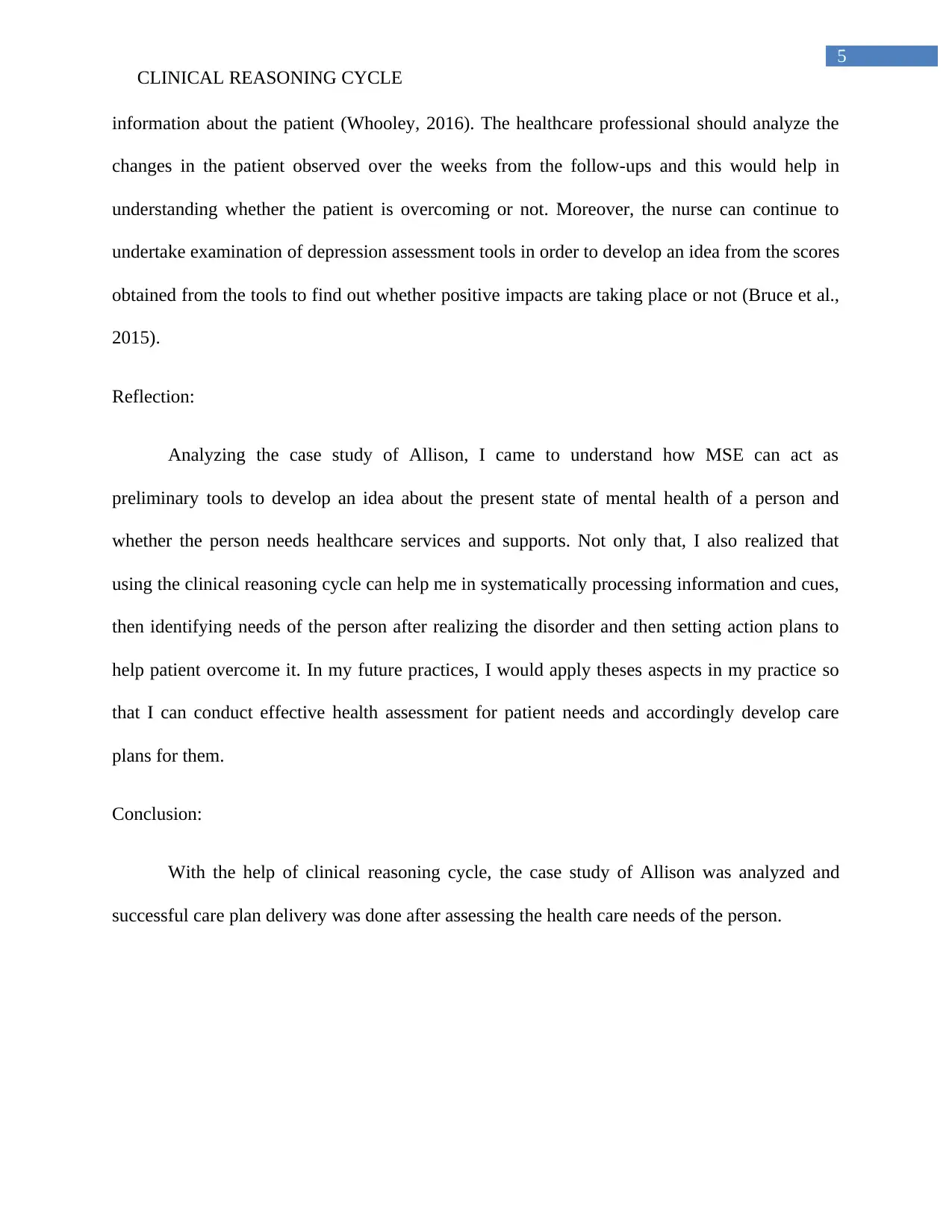
5
CLINICAL REASONING CYCLE
information about the patient (Whooley, 2016). The healthcare professional should analyze the
changes in the patient observed over the weeks from the follow-ups and this would help in
understanding whether the patient is overcoming or not. Moreover, the nurse can continue to
undertake examination of depression assessment tools in order to develop an idea from the scores
obtained from the tools to find out whether positive impacts are taking place or not (Bruce et al.,
2015).
Reflection:
Analyzing the case study of Allison, I came to understand how MSE can act as
preliminary tools to develop an idea about the present state of mental health of a person and
whether the person needs healthcare services and supports. Not only that, I also realized that
using the clinical reasoning cycle can help me in systematically processing information and cues,
then identifying needs of the person after realizing the disorder and then setting action plans to
help patient overcome it. In my future practices, I would apply theses aspects in my practice so
that I can conduct effective health assessment for patient needs and accordingly develop care
plans for them.
Conclusion:
With the help of clinical reasoning cycle, the case study of Allison was analyzed and
successful care plan delivery was done after assessing the health care needs of the person.
CLINICAL REASONING CYCLE
information about the patient (Whooley, 2016). The healthcare professional should analyze the
changes in the patient observed over the weeks from the follow-ups and this would help in
understanding whether the patient is overcoming or not. Moreover, the nurse can continue to
undertake examination of depression assessment tools in order to develop an idea from the scores
obtained from the tools to find out whether positive impacts are taking place or not (Bruce et al.,
2015).
Reflection:
Analyzing the case study of Allison, I came to understand how MSE can act as
preliminary tools to develop an idea about the present state of mental health of a person and
whether the person needs healthcare services and supports. Not only that, I also realized that
using the clinical reasoning cycle can help me in systematically processing information and cues,
then identifying needs of the person after realizing the disorder and then setting action plans to
help patient overcome it. In my future practices, I would apply theses aspects in my practice so
that I can conduct effective health assessment for patient needs and accordingly develop care
plans for them.
Conclusion:
With the help of clinical reasoning cycle, the case study of Allison was analyzed and
successful care plan delivery was done after assessing the health care needs of the person.
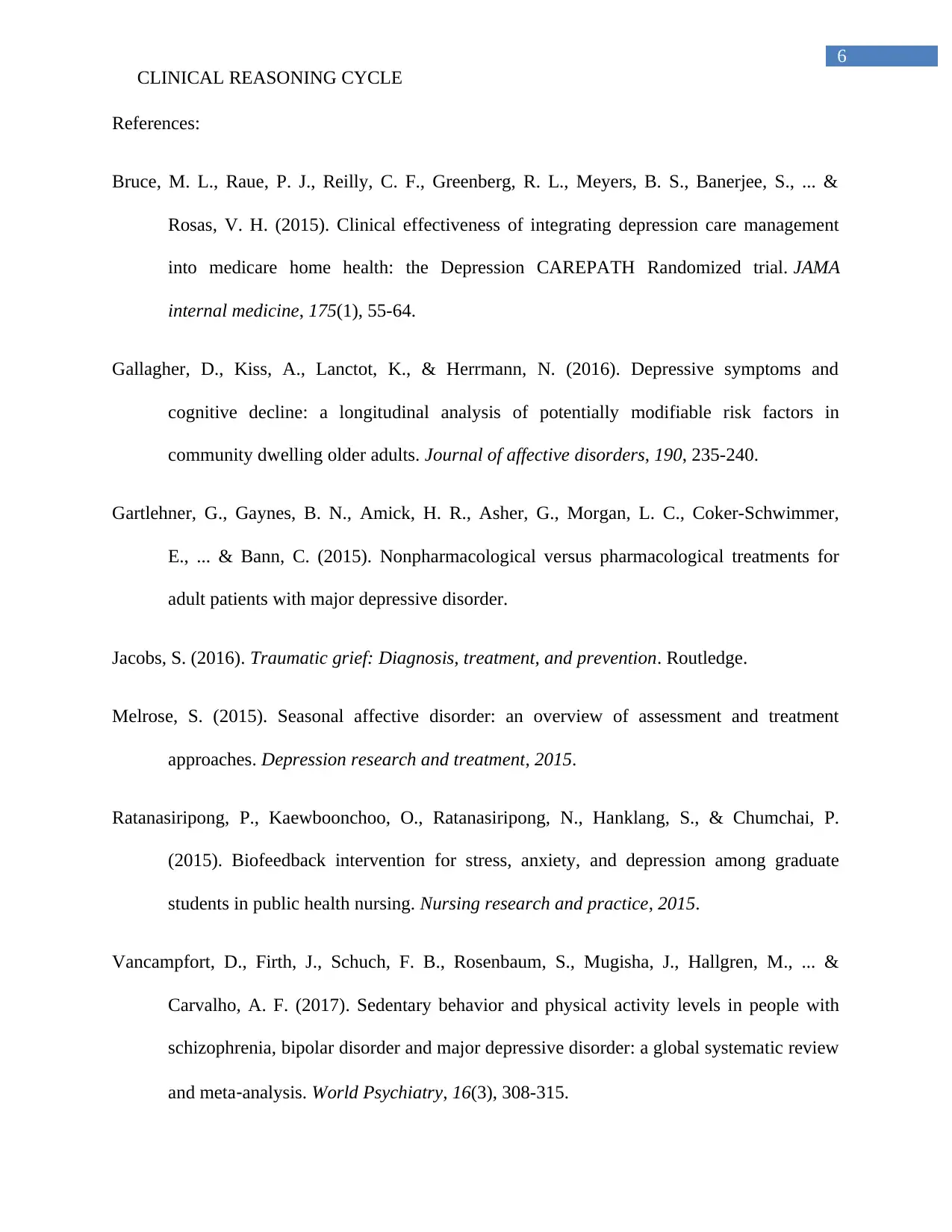
6
CLINICAL REASONING CYCLE
References:
Bruce, M. L., Raue, P. J., Reilly, C. F., Greenberg, R. L., Meyers, B. S., Banerjee, S., ... &
Rosas, V. H. (2015). Clinical effectiveness of integrating depression care management
into medicare home health: the Depression CAREPATH Randomized trial. JAMA
internal medicine, 175(1), 55-64.
Gallagher, D., Kiss, A., Lanctot, K., & Herrmann, N. (2016). Depressive symptoms and
cognitive decline: a longitudinal analysis of potentially modifiable risk factors in
community dwelling older adults. Journal of affective disorders, 190, 235-240.
Gartlehner, G., Gaynes, B. N., Amick, H. R., Asher, G., Morgan, L. C., Coker-Schwimmer,
E., ... & Bann, C. (2015). Nonpharmacological versus pharmacological treatments for
adult patients with major depressive disorder.
Jacobs, S. (2016). Traumatic grief: Diagnosis, treatment, and prevention. Routledge.
Melrose, S. (2015). Seasonal affective disorder: an overview of assessment and treatment
approaches. Depression research and treatment, 2015.
Ratanasiripong, P., Kaewboonchoo, O., Ratanasiripong, N., Hanklang, S., & Chumchai, P.
(2015). Biofeedback intervention for stress, anxiety, and depression among graduate
students in public health nursing. Nursing research and practice, 2015.
Vancampfort, D., Firth, J., Schuch, F. B., Rosenbaum, S., Mugisha, J., Hallgren, M., ... &
Carvalho, A. F. (2017). Sedentary behavior and physical activity levels in people with
schizophrenia, bipolar disorder and major depressive disorder: a global systematic review
and meta‐analysis. World Psychiatry, 16(3), 308-315.
CLINICAL REASONING CYCLE
References:
Bruce, M. L., Raue, P. J., Reilly, C. F., Greenberg, R. L., Meyers, B. S., Banerjee, S., ... &
Rosas, V. H. (2015). Clinical effectiveness of integrating depression care management
into medicare home health: the Depression CAREPATH Randomized trial. JAMA
internal medicine, 175(1), 55-64.
Gallagher, D., Kiss, A., Lanctot, K., & Herrmann, N. (2016). Depressive symptoms and
cognitive decline: a longitudinal analysis of potentially modifiable risk factors in
community dwelling older adults. Journal of affective disorders, 190, 235-240.
Gartlehner, G., Gaynes, B. N., Amick, H. R., Asher, G., Morgan, L. C., Coker-Schwimmer,
E., ... & Bann, C. (2015). Nonpharmacological versus pharmacological treatments for
adult patients with major depressive disorder.
Jacobs, S. (2016). Traumatic grief: Diagnosis, treatment, and prevention. Routledge.
Melrose, S. (2015). Seasonal affective disorder: an overview of assessment and treatment
approaches. Depression research and treatment, 2015.
Ratanasiripong, P., Kaewboonchoo, O., Ratanasiripong, N., Hanklang, S., & Chumchai, P.
(2015). Biofeedback intervention for stress, anxiety, and depression among graduate
students in public health nursing. Nursing research and practice, 2015.
Vancampfort, D., Firth, J., Schuch, F. B., Rosenbaum, S., Mugisha, J., Hallgren, M., ... &
Carvalho, A. F. (2017). Sedentary behavior and physical activity levels in people with
schizophrenia, bipolar disorder and major depressive disorder: a global systematic review
and meta‐analysis. World Psychiatry, 16(3), 308-315.
Paraphrase This Document
Need a fresh take? Get an instant paraphrase of this document with our AI Paraphraser

7
CLINICAL REASONING CYCLE
Whooley, M. A. (2016). Screening for depression—a tale of two questions. JAMA internal
medicine, 176(4), 436-438.
CLINICAL REASONING CYCLE
Whooley, M. A. (2016). Screening for depression—a tale of two questions. JAMA internal
medicine, 176(4), 436-438.
1 out of 8
Related Documents
Your All-in-One AI-Powered Toolkit for Academic Success.
+13062052269
info@desklib.com
Available 24*7 on WhatsApp / Email
![[object Object]](/_next/static/media/star-bottom.7253800d.svg)
Unlock your academic potential
© 2024 | Zucol Services PVT LTD | All rights reserved.





